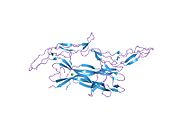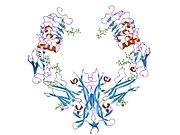Nerve growth factor
Ensembl | |||||||||
|---|---|---|---|---|---|---|---|---|---|
| UniProt | |||||||||
| RefSeq (mRNA) | |||||||||
| RefSeq (protein) | |||||||||
| Location (UCSC) | Chr 1: 115.29 – 115.34 Mb | Chr 3: 102.38 – 102.43 Mb | |||||||
| PubMed search | [3] | [4] | |||||||
| View/Edit Human | View/Edit Mouse |
Nerve growth factor (NGF) is a
Structure
NGF is initially in a 7S, 130-
The term nerve growth factor usually refers to the 2.5S, 26-kDa beta subunit of the protein, the only component of the 7S NGF complex that is biologically active (i.e. acting as a signaling molecule).
Function
As its name suggests, NGF is involved primarily in the growth, as well as the maintenance, proliferation, and survival of nerve cells (neurons) and is critical for the survival and maintenance of sympathetic and
However, several recent studies suggest that NGF is also involved in pathways besides those regulating the life cycle of neurons.Neuronal proliferation
NGF can drive the expression of genes such as bcl-2 by binding to the Tropomyosin receptor kinase A, which stimulates the proliferation and survival of the target neuron.
High affinity binding between proNGF, sortilin, and
Proliferation of pancreatic beta cells
There is evidence that pancreatic beta cells express both the TrkA and p75NTR receptors of NGF. It has been shown that the withdrawal of NGF induces apoptosis in pancreatic beta cells, signifying that NGF may play a critical role in the maintenance and survival of pancreatic beta cells.[8]
Regulation of the immune system
NGF plays a critical role in the regulation of both innate and acquired immunity. In the process of inflammation, NGF is released in high concentrations by mast cells, and induces axonal outgrowth in nearby nociceptive neurons. This leads to increased pain perception in areas under inflammation. In acquired immunity, NGF is produced by the Thymus as well as CD4+ T cell clones, inducing a cascade of maturation of T cells under infection.[9]
Ovulation
NGF is abundant in seminal plasma. Recent studies have found that it induces ovulation in some mammals e.g. "induced" ovulators, such as llamas. Surprisingly, research showed that these induced animals will also ovulate when semen from on-schedule or "spontaneous" ovulators, such as cattle is used. Its significance in humans is unknown. It was previously dubbed ovulation-inducing factor (OIF) in semen before it was identified as beta-NGF in 2012.[10]
Mechanism of action
NGF binds with at least two classes of receptors: the
When NGF binds to the TrkA receptor, it drives the homodimerization of the receptor, which in turn causes the autophosphorylation of the tyrosine kinase segment. Alternatively, the p75NTR receptor can form a heterodimer with TrkA, which has higher affinity and specificity for NGF.
Studies suggest that NGF circulates throughout the entire body via the blood plasma, and is important for the overall maintenance of homeostasis.[14]
Neuron survival
Binding interaction between NGF and the TrkA receptor facilitates receptor dimerization and tyrosine residue phosphorylation of the cytoplasmic tail by adjacent Trk receptors.[15] Trk receptor phosphorylation sites operate as Shc adaptor protein docking sites, which undergo phosphorylation by the TrkA receptor[7] Once the cytoplasmic adaptor protein (Shc) is phosphorylated by the receptor cytoplasmic tail, cell survival is initiated through several intracellular pathways.
One major pathway leads to the activation of the serine/threonine kinase,
A second pathway contributing to cell survival occurs through activation of the mitogen-activated protein kinase (
Both Akt and RSK, components of the PI3K-Akt and MAPK pathways respectively, act to phosphorylate the cyclic AMP response element binding protein (
History
Rita Levi-Montalcini and Stanley Cohen discovered NGF in the 1950s while faculty members at Washington University in St. Louis. The critical discover was done by Levi-Montalcini and Hertha Meyer at the Carlos Chagas Filho Biophysics Institute of the Federal University of Rio de Janeiro in 1952. Their publication in 1954[17] became the definitive proof for the existence of the protein.[18][19] Levi-Montalcini later remarked:
The tumor had given a first hint of its existence in St. Louis but it was in Rio de Janeiro that it revealed itself, and it did so in a theatrical and grand way, as if spurred by the bright atmosphere of that explosive and exhuberant manifestation of life that is the Carnival in Rio.[20]
However, its discovery, along with the discovery of other neurotrophins, was not widely recognized until 1986, when it won the Nobel Prize in Physiology or Medicine.[21][22][23]
Studies in 1971 determined the
NGF is abundant in seminal plasma. Recent studies have found that it induces ovulation in some mammals.[24] Nerve Growth Factors (NGF) were initially discovered due to their actions during development, but NGF are now known to be involved in the function throughout the life of the animal.[25]
Interactions
Nerve growth factor has been shown to
Clinical Use
NGF, specifically mouse (murine) nerve growth factor, has been available as a licensed medicine in China since 2003.[27] There is evidence of improved patient outcomes for several diseases of the nervous system, including acute intracerebral hemorrhage,[28] global developmental delay,[29] optic atrophy,[30] epilepsy [31] and cerebral palsy.[32] This is significant as there are few medicines which can treat injuries and diseases of the nervous system. Research and clinical use outside of China is limited despite a large body of evidence supporting its use.
See also
- Protein targeting
- Nervous system
- VGF Nerve Growth Factor-inducible, a protein whose expression is induced by NGF
- Neurotrophin
- Nerve growth factor receptor
- Growth factor
- Brain-derived neurotrophic factor
References
- ^ a b c GRCh38: Ensembl release 89: ENSG00000134259 – Ensembl, May 2017
- ^ a b c GRCm38: Ensembl release 89: ENSMUSG00000027859 – Ensembl, May 2017
- ^ "Human PubMed Reference:". National Center for Biotechnology Information, U.S. National Library of Medicine.
- ^ "Mouse PubMed Reference:". National Center for Biotechnology Information, U.S. National Library of Medicine.
- PMID 14699960.
- S2CID 872149.
- ^ ISBN 978-0-12-374539-2.
- PMID 11692177.
- PMID 9314355.
- PMID 22908303.
- Meghan Rosen (August 20, 2012). "Ovulation spurred by newfound semen ingredient". Science News. Archived from the original on 2012-08-24.
- ^ PMID 24023598.
- S2CID 4337786.
- PMID 25619719.
- PMID 14699984.
- S2CID 4241996.
- ^ PMID 9526010.
- from the original on 2024-01-11. Retrieved 2024-01-11.
- from the original on 2024-01-11. Retrieved 2024-01-11.
- from the original on 2024-01-11. Retrieved 2024-01-11.
- from the original on 2024-01-11. Retrieved 2024-01-11.
- ^ "The 1986 Nobel Prize in Physiology or Medicine for discoveries of growth factors". Archived from the original on 2008-12-02. Retrieved 2005-11-30.
- ^ Presentation Speech by Professor Kerstin Hall The Nobel Prize in Physiology or Medicine 1986 Archived 2008-10-13 at the Wayback Machine
- ^ "Rita Levi-Montalcini – Nobel Lecture". Archived from the original on 2008-08-28. Retrieved 2005-11-30.
- ^ "Ovulation spurred by newfound semen ingredient". 20 August 2012. Archived from the original on 2021-10-28. Retrieved 2021-10-28.
- ^ Adelman, George. Encyclopedia of Neuroscience . Boston: Birkhhaeuser, 1987. Print.[ISBN missing][page needed]
- S2CID 4343450.
- PMID 26109961.
- S2CID 220844712.
- from the original on 2023-01-20. Retrieved 2024-02-23.
- ISSN 1004-5775.
- ISSN 2096-1413.
- ISSN 2095-428X.
External links
- Nerve+Growth+Factor at the U.S. National Library of Medicine Medical Subject Headings (MeSH)
- Overview of all the structural information available in the PDB for UniProt: P01138 (Human Beta-nerve growth factor) at the PDBe-KB.
- Overview of all the structural information available in the PDB for UniProt: P01139 (Mouse Beta-nerve growth factor) at the PDBe-KB.





